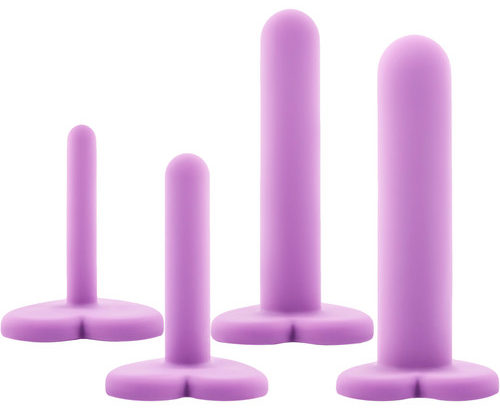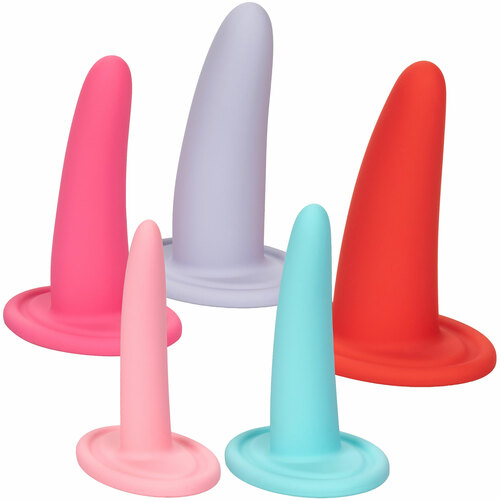
“This clam is jammed!” I once quipped to a guy I was chatting up. It was a light-hearted way to start the “I can’t have vaginal sex” conversation that came up every time I wanted to get laid in my 20’s.
I always try to talk about my vaginismus in humorous terms. It helps me normalize the condition, and it stops me from feeling compulsively apologetic or ashamed. I’m not broken. I’ve just got a haunted vagina.
Maybe one day I’ll bust these ghosts, but for now, my vag isn’t tolerating tourists. The VIP list is vaginal dilators (and the occasional dildo) only.
Let’s talk about how that works!
Quick Post Navigation
What is vaginismus?
Vaginismus is the involuntary tensing of pelvic floor muscles that painfully limits or fully prevents vaginal penetration. It can also cause incontinence, cramping, back pain, and chronic constipation. While an obvious struggle of vaginismus is being unable to have penetrative sex (whether that’s with a penis, fingers, or insertable sex toy), vaginismus also complicates pregnancy, gynecological exams, and menstrual product options (notably tampons and menstrual cups.)
What’s believed to cause vaginismus (which is still an under-researched condition) is individual. Seeing a mental health professional to investigate underlying psychological stressors is usually part of vaginismus treatment. Common stressors include poor body image, sexual abuse trauma, sex negative upbringing, medically inaccurate sex education, traumatic birth, past pain (such as from surgery, illnesses, or accidents), and sex or relationship related anxieties. Whatever the cause, the sufferer’s pelvic floor muscles have developed an unconscious protective “flinch”.
It can take years to overcome vaginismus, and the journey is often nonlinear. Treatment plans vary and are a collaborative effort between you and your doctor(s), and can even include seeing a physical therapist. A common component in vaginismus recovery is using vaginal dilators.

What are dilators? What are dilators used for?
While the marketing and language around dilators tends to be very medical and sterile, dilators are not much different from dildos. Dilators are typically uniformly plain, textureless lengths of silicone, plastic, or glass, that gradually increase in height and width. They start out thinner and shorter than a finger (somewhere between 0.5’ and 0.75’ in diameter), and usually end at the size of an average penis or dildo (a 1.5’ diameter.)
Vaginal dilators are used for more than vaginismus. They can be helpful after surgery or injurious childbirth. They can be used to soften vaginal scarring or help establish and maintain elasticity after vaginoplasty. Dilators may be part of treatment for vaginal agenesis, pelvic radiation recovery (vaginal stenosis), vaginal atrophy, and other pelvic floor dysfunctions.
How do dilators work?
There are many misconceptions around dilators, which aren’t helped by how often they’re recommended by doctors without instructional follow up. Dilators take time and consistency to be effective; you don’t use them all at once, and they don’t cure vaginismus in a handful of sessions. Dilating is a process, and progress can be slow.
Exact usage regimens depend on your diagnosis and the treatment plan established by your medical team. (If they don’t volunteer one themselves, ask directly.) Dilators are used daily or several times weekly for 15 minutes to 2 hours depending on your needs. You start off with the smallest size you’re able to take without pain; mild discomfort is normal, shooting or stabbing pain is not.
After your body learns to accommodate the dilator through weeks of regular use, you can graduate to a larger size. If the next size up is painful, you resume using the smaller size. If you’re struggling to size up, or if even the smallest size is too painful, you can practice relaxing your pelvic floor muscles (discussed below) in anticipation of trying again.
What’s the point? Well, dilators’ value is two-fold. First, using them retrains your pelvic floor muscles to accept penetration. Secondly, it gives your body safe, positive penetration experiences to help divorce the act from past trauma or anxieties.
Where can you buy dilators?
SheVibe, the LGBT friendly sex shop that commissioned this piece, has numerous dilator options! They offer free shipping in the US on orders over $68 USD.

If you are in the UK and wondering where to buy dilators, I recommend the Pleasure Garden.

How to Use Dilators for Vaginismus: Step by Step Guide
Step 1: Take the time to relax first.
Dilating can be stressful. It’s emotionally and physically vulnerable, and it can be time-consuming. But a stressed body is a tense body; trying to do your dilating routine while anxious will only make it more difficult.
If your schedule permits, try to take the time to unwind first. Put on some music or a low-energy Youtube video, read the next chapter in your book, meditate, play Stardew Valley, or break out the crayons and an adult coloring book. Whatever chills you out!
Note: Depending on your relationship with your body and how you feel about dilating, you may decide to pair your routine with masturbation. That’s totally okay! Physical arousal can help make dilating easier because the cervix retracts and the vaginal canal lengthens. (Orgasm causes your vaginal muscles to flex, however, so consider removing your dilator beforehand to avoid discomfort.)
And if using dilators during masturbation is not for you? That’s okay too!
Step 2: Relax your pelvic floor muscles.
Pelvic floor muscles are often described as the “basket” or “hammock” of muscle that hold up your pelvic organs (like the bladder and uterus.) Contracting them creates a wave-like sensation, with the muscles simultaneously tensing and rising. (This should be localized. If you’re clenching your thighs or your butt cheeks, you’re manipulating the wrong muscles!)
When pelvic floor muscles are brought up, it’s usually in the context of strengthening them with kegel exercises (often aided by kegel balls.) But conditions such as vaginismus mean that the pelvic floor is too tense, and these exercises can actually make things worse. Instead, you need to learn to relax them.
Ashley Lauretta of Women’s Running outlined 4 pelvic floor relaxation exercises that I’ve found pretty useful when preparing for using my dilator.

Step 3: Liberally lubricate your dilator.
Lube is an incredible ally in combating penetration-related pain. For dilators, a good water-based lubricant is key, because most dilators are made of silicone and thus cannot be used with silicone lube. (Don’t worry, though, you can store silicone toys and dilators together.)
My favorite lube for dilating (and everything else) is Sliquid Sassy. It’s thicker than a lot of water-based lubes, but isn’t gloopy or sticky. Sliquid is made without sugary ingredients like glycerin, which is an irritant that can cause yeast infections (especially for folks with sensitive vaginas.)
While it can be tempting to use a numbing lubricant, these are dangerous because they dull your body’s ability to notice and warn you of potential harm. Accidentally going too fast and ending up sore won’t help your progress.
Step 4: Find a position that feels comfortable to you.
Your first instinct for dilating may be to lay on your back with your thighs spread wide. This position (and others) can inadvertently strain your pelvic floor muscles. You can modify it by raising one or both knees towards your chest, which lessens the strain and can allow for deeper penetration. You can also use pillows or a Liberator wedge to lift your hips.
Positions where you’re on your stomach or hands and knees aren’t recommended because they compress the vaginal canal, but everyone’s body is different and you may find these positions are psychologically more relaxing! Laying on your side or sitting on your butt with your pelvis raised are both great options.

Step 5: Be present during insertion.
It can be tempting to try to speed through the process by just shutting your eyes and pushing the dilator in as quickly as possible. But that defeats the purpose of dilating.
When initially inserting the dilator, I try to take my time and pay attention to the way my body opens. How does the mouth of my vagina feel around the dilator’s tip? Can I feel the way my internal muscles hesitate and then yield? Is there any part of my vagina I can feel, or is the sensation just a nondescript ache? Is insertion easier or harder than yesterday, and what’s different about today’s session that could impact that? How does it feel when I breathe?
I generally use more than one dilator in a session. I find that my body responds best to starting with the kit’s smallest size and then switching out until I’m at my current limit, which provides me with a gradual stretch instead of an immediate one.
You may have to experiment with how you insert your dilators (especially if they’re rigid or curved.) I find pointing it downward towards my spine is easier than angling it upward as though targeting my g-spot, but your preference may be completely different.
Step 6: Pass the time.
Some folks find gently thrusting their dilators to be useful, others don’t. This is entirely dependent on your needs and comfort.
If your dilating sessions are lengthy and your dilators are designed for it*, once they’re inserted you can move into another position. I will often masturbate or get dressed in tight bottoms and go play video games or work on an article. This can cause minor discomfort because sitting on the dilator forces me to accommodate its full length, but as long as it doesn’t veer into pain, I stick with it. If I’m sitting upright, putting my weight on my butt cheeks and keeping my crotch arched helps alleviate some of the pressure.
If you’re not comfortable moving around or if your sessions are too short to bother, having an audio book ready or a bustling Twitter feed to scroll can help turn dilating into moments of treasured privacy instead of a laborious chore.
(*Kits such as the Blush Wellness Dilator Kit and the She-Ology Wearable Dilator Set are designed for comfortable use while moving/multitasking.)
Step 7: Be patient with your body.
Your body is not your enemy. You’re not working against your body, you’re working with your body to find a path to healing. The pacing of your progress is not indication of brokenness or failure. And you are not alone in your frustrations, fellow ghost buster.
If you have vaginismus and want the support of peers who are coping with the same issues that you are, please visit The Vaginismus Network or r/Vaginismus. You can also reach out to me on Twitter.
This piece is a lightly edited version of an educational blog post I wrote for the literal superhero sex shop, SheVibe.
This post includes affiliate links. While using these links to make a purchase comes at no extra cost to you, it helps keep my website running.




3 Comments